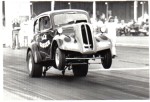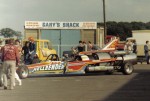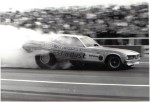Through the intervening years, the abundance of massive engines, and the general excitement encouraged teenagers to embrace this hobby, and often 'drag-racing' would be used as a means to settle other disputes without the need to engage in physical violence, the final 'Trophy' being the prestige of winning the race, or ultimately claiming the 'Pink Slip' (The American equivalent of our Log-Book)
In 1948/9 Following the diligent efforts of Magazine Editor and Drag racing enthusiast Wally Parks, a National Speed Week took place on the salt flats of Bonnneville, Utah. Where racers were first offered the opportunity to race 'against the clock' - which was actually a stopwatch - coaxing their vehicles to accelerate quicker rather than to simply attain high top speeds..
The first drag strip, the Santa Ana Drags, began running on an airfield in Southern California in 1950. And quickly gained popularity among the spectators due to the revolutionary computerised speed clocks.
Drag Racing took off in the UK during the 1960's when, like in the USA, many of the old disused airstrips around the country were converted to drag strips.
Podington airfield, near the villages of Hinwick and Podington, was formerly a wartime airbase used by the USAAF during the Second World War. In 1966 permission was obtained to use the airfield as a drag racing complex, the ¾ of a mile main runway being used as the drag strip. The track was named Santa Pod after the Santa Ana strip in America, combined with the name of the local village of Podington.
 Since then the name Santa Pod has become synonymous with the sport of Drag Racing in Europe. Today the raceway hosts events throughout the year including the FIA European Drag Racing Championships and the 'Run What You Brung' (RWYB) events where anyone with a valid driving licence can have a go and put their own vehicles and skills to the test.
Since then the name Santa Pod has become synonymous with the sport of Drag Racing in Europe. Today the raceway hosts events throughout the year including the FIA European Drag Racing Championships and the 'Run What You Brung' (RWYB) events where anyone with a valid driving licence can have a go and put their own vehicles and skills to the test.
Throughout the years, the engines and vehicles have evolved significantly through technological advances and access to more sophisticated engines, During the mid 1950's a V8 powered Drag racing car could be expected to reach a speed of 110 MPH after the 1/4 mile, various methods were employed to squeeze more power out of these Massive engines and by 1957, a top speed of 168MPH was achieved by Emery Cook, using a Nitromethane fuelled car.
This Progress has continued to this day and on Drag srtrips around the world it is not uncommon to see Engines that produce in excess of 2000 Horsepower, with some that are capable of over 6000 HP. Modern vehicles utilising a traditional Internal combustion engine would often be able to reach speeds of over 350 MPH. Of course, Safety is always a major consideration when designing these vehicles and this has encouraged designers to use rear engined cars, this has promoted great advances in Performance and safety, with todays Top Fuel dragsters being computer designed wonders with sleek profiles and wind tunnel-tested rear aerofoils that exert 5,000 pounds of downforce on the rear tyres with minimal aerodynamic drag.
Although the tiyetracks of dragracing history are clear, the origin of the term 'drag racing' is not. The theories are almost as many and varied as the machines that have populated its ranks for five decades. Explanations range from a simple challenge ("Drag your car out of the garage and race me!") to geographical locale (the "main drag" was a city's main street, often only wide enough to accommodate two vehicles) to the mechanical (to "drag" the gears meant to hold the transmission in gear loner than normal)
 The latest development to be seen thrilling spectators on the drag strips is the 'Jet cars' - these vehicles resemble a standard bodied car, but lurking below the cosmetic body panels is a Jet engine complete with afterburner from a jet aeroplane. These brutes develop more than 5000 pounds of thrust and can propel the vehicle along the strip at over 270 MPH.
The latest development to be seen thrilling spectators on the drag strips is the 'Jet cars' - these vehicles resemble a standard bodied car, but lurking below the cosmetic body panels is a Jet engine complete with afterburner from a jet aeroplane. These brutes develop more than 5000 pounds of thrust and can propel the vehicle along the strip at over 270 MPH.
When you consider that modern drag racing vehicles develop over 20 times more power than a family saloon car, and often uses 15 Gallons to cover the ¼ mile this represents a return of around 60 Gallons/Mile ( 0.017MPG) no-one can deny that this is a truly spectacular and underestimated sport.
I have compiled some snippets of past Drag-racing events and documentaries that will illustrate Drag racing's highlights......
These notes have been compiled using Original material and excerpts from the following web resources:
http://www.draglist.com
http://www.hardcore50.com
http://www.austinworks.com
http://www.nhra.com
http://www.santapod.co.uk
